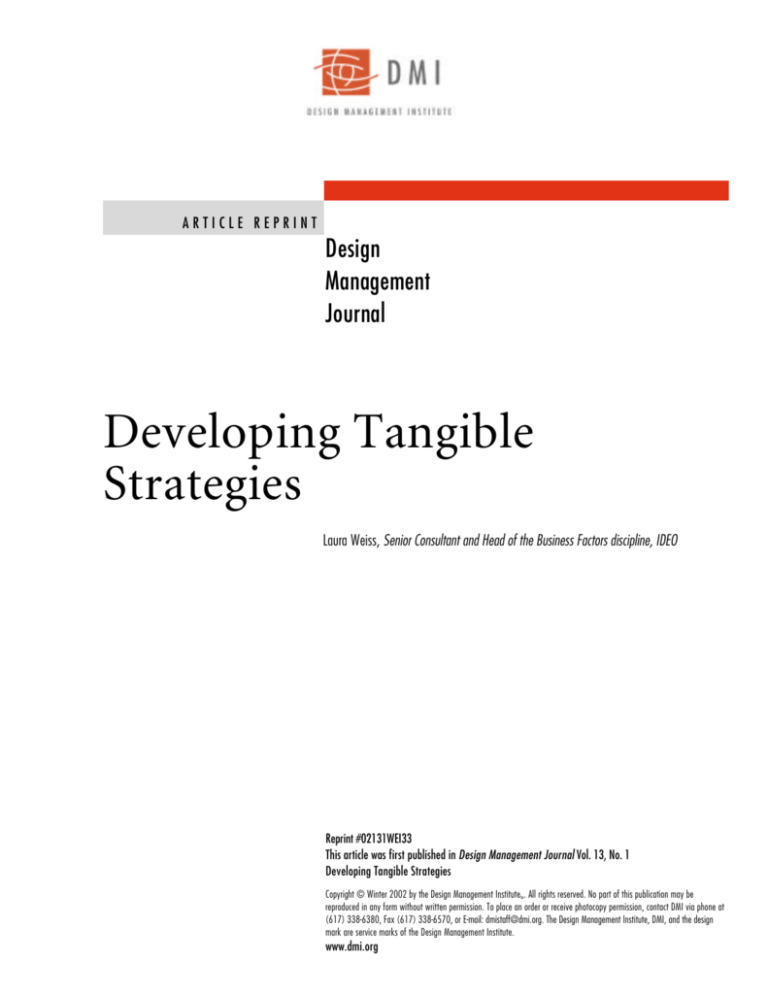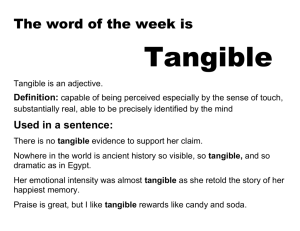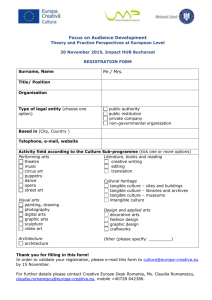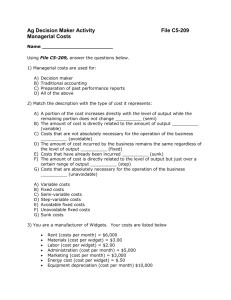
ARTICLE REPRINT
Design
Management
Journal
Developing Tangible
Strategies
Laura Weiss, Senior Consultant and Head of the Business Factors discipline, IDEO
Reprint #02131WEI33
This article was first published in Design Management Journal Vol. 13, No. 1
Developing Tangible Strategies
Copyright © Winter 2002 by the Design Management Institute . All rights reserved. No part of this publication may be
reproduced in any form without written permission. To place an order or receive photocopy permission, contact DMI via phone at
(617) 338-6380, Fax (617) 338-6570, or E-mail: dmistaff@dmi.org. The Design Management Institute, DMI, and the design
mark are service marks of the Design Management Institute.
SM
www.dmi.org
S T R AT E G Y
Developing
tangible strategies
by Laura Weiss
s businesses ponder where to put their resources to assure future success, they are
increasingly turning to innovation firms to help sort out the options related to these
long-term decisions. Laura Weiss presents a framework consultants can use to lead clients
from “discovery” to “delivery,” a design-grounded process that becomes a pragmatic
“innovation engine” by combining expertise in human, technical, and business factors.
A
Laura Weiss, Senior
Consultant and Head of
the Business Factors
discipline, IDEO
Today, almost everyone is familiar with
the now-famous statement made in
the late 1950s by former IBM CEO
Thomas Watson Jr., that “Good design
is good business.” That concept, a
breakthrough in the post-World War II
industrial era, was grounded in the
belief that a commitment to design
would help a good product to reach its
full potential, presumably through
increased sales of a more functionally
robust and aesthetically pleasing object.
Today, Watson’s philosophy has
proven sustainable, if no longer novel,
and there is much contemporary
evidence to that fact. The Polaroid
I-Zone, with its creative reinterpretation of the simplest camera, has made
instant photography relevant to a
whole new generation of users (and
became the number-one-selling camera
within months of its introduction).1
Similarly, the Palm V, with its elegant
reinterpretation of the Palm Pilot,
made the high-tech functionality of its
predecessor appealing to a much wider
and more mainstream audience. Both
products are strong examples of design
making a difference to a company’s
top-line growth. And yet, for every
Palm V, there’s an Apple Power Mac G4
Cube or 3Com Audrey—products
whose design boldness failed to save
1. The I-Zone leveraged Polaroid’s instantfilm technology, which contributed to its
success. Yet, the company was disastrously
late in joining the digital revolution—proving
once again that good design is not always
good business, if larger strategic issues aren’t
being taken into account when new products
are developed.
Design Management Journal Winter 2002
33
Design as Interface
them from a marketplace failure due to either an
inadequate understanding of target users, a poor
business plan, or both. Good design, it seems, is
not always good business if it is not pursued as
an integral part of a wider set of activities that
together enable the most successful innovations
to happen.
But if Tom Watson’s statement does not tell
the entire story, it at least signals the beginning
of a burgeoning design awareness that some 40
years later has been propagated by management
evangelists such as Tom
Peters, Gary Hamel,
and many others.
Design is now firmly
part of the lexicon of
innovation—the
ultimate expression
of applied technology,
design, and business
sensibilities. In a special
1999 issue dedicated
to the topic of innovation in industry, The
Economist proclaimed, “Innovation has become
the industrial religion of the late 20th century.”2
The article goes on to point out that innovation
can manifest itself in ways that are not just limited to the production of a consumable product.
Today’s companies and organizations, driven
by market dynamics, social and environmental
issues, technological developments, and even
government deregulation, view innovation as the
perpetual “next frontier” and the key to achieving a competitive or operational advantage. As
such, everything is now subject to innovation—
not just physical objects, but also political systems, economic policy, ways in which medical
research is conducted, and even complete “user
experiences” (for example, a passenger’s journey
with Amtrak’s new Acela service). It is no surprise, then, that the application of design sensibilities and skills now extends to innovations
as varied as online interactions (Amazon.com’s
One-Click feature) and improved business
processes (the application that enables that
same feature). Both of these connect consumers
and providers in ways that ultimately contribute
to larger industry innovations.
“Should we be designing
a new widget, a new
widget and service
bundle, or something
else altogether?”
services that can provide expertise and a fresh
perspective. If these services are to provide value
by delivering meaningful results, what exactly do
their clients need in addition to superior design?
The requirements are no longer limited to the
“well-defined problem,” in which a project brief
addresses a fairly well understood and presumably stable business context. Today, much bigger
questions are being asked, which move beyond
product specifications to broader, more challenging issues. Instead of asking the consultant
to “design this new widget for me,” where the
widget is already identified, a client might ask,
“Should we be designing a new widget, a new
widget and service bundle, or something else
altogether?” The following is a basic typology of
innovation challenges a provider of innovation
services might typically encounter today.
The loosely defined problem: The client
presents a preliminary business plan or a
nascent product idea, without a clear business case. The client might ask, “Where, and
how, should we be looking for breakthrough
opportunities that address customer needs
and meet our business objectives?”
The too-many-options problem: The client
lacks effective tools to select and implement
the most promising option(s). The client
might ask, “If we already know where we
want to focus our business, how do we
generate and select product or service
concepts that will get us there?”
The technology investment problem:
The client is seeking commercialization
options or validation for investing in a new
technology, new applications for an existing
technology, or knowledge of external
technology threats. The client might ask,
“What is the impact of future technology
on this product/service?”
The innovation void problem: The client
would like to develop a more innovative and
sustainable approach to its internal product
development process. The client might ask,
“How can we develop a vision of the future
for our products so that we can plan and
guide continued innovation efforts?”
Regardless of which challenge (or hybrid
Evidence of broader needs
As the quest for breakthrough innovation has
increased, so too has the demand for consulting
34
Design Management Journal Winter 2002
2. Valery, Nicholas. “A Survey of Innovation in Industry.”
The Economist, February 20, 1999.
Developing tangible strategies
Figure 1.
Extending core services to strengthen the connection between business needs and user needs
version) has been articulated, the client’s most
immediate need is to identify an appropriate
direction for the innovation effort before it
can actually embark on it. Thus the demand
for consulting services is increasingly focused
on turnkey solutions that incorporate additional
upstream and downstream activities that facilitate critical decision making associated with
the earliest stages of new product and service
development. Whereas traditional core services
offered by design consultancies and others focus
on helping clients do things the right way in
terms of design, engineering, and manufacturing, now they are being engaged for “strategic
services” to help them choose to do the right
things in the first place (figure 1).
Enabling discovery, decisions, and delivery
Because innovation programs today are increasingly strategic, traditional design services must
grow and develop the additional capabilities
needed not only to serve clients more effectively
but also to increase the likelihood that the
results of their engagement will be a product or
service that eventually gets to market as a truly
successful innovation. In the summer 1999
Design Management Journal, IDEO’s Tom Kelley
argued that designers are well positioned to help
companies seeking to unlock their capacity for
innovation because they naturally take an inductive approach to the problem-solving process,
and employ powerful visualization tools to communicate the results.3 Today, that theory is put
into practice at consultancies like IDEO, whose
industrial design and engineering activities
(along with the substantially critical roles of
human factors and interaction design) are being
expanded even further to incorporate the investigation of business factors. As discussed earlier,
business issues have long been part of the
innovation equation, but they have often been
pursued in isolation and independently from the
creative side. A more powerful approach, it can
be argued, involves the concurrent exploration of
issues associated with user desirability, technical
feasibility, and business viability by an
interdisciplinary team that utilizes design-based
processes and communication tools.
The innovation engine
By leveraging expertise in each of the interrelated areas of human factors, technical factors,
and business factors to address the client’s innovation problem, the consultant can help lower
the functional barriers that often restrict, rather
than inform, breakthrough innovation within a
typical business organization. For example, the
elusive issue of desirability (or what motivates
consumer behavior) demands an understanding
of how people interpret and interact with the
things they encounter in the world—including
new technologies or even new business models.
Exploring feasibility means understanding how
those new technologies can be harnessed to
3. Tom Kelley, “Designing for Business, Consulting for
Innovation,” Design Management Journal, vol. 10, no. 3
(Summer 1999), p. 30.
Design Management Journal Winter 2002
35
Design as Interface
Figure 2.
The innovation engine: Design sits at the intersection, as an enabler
and the result of integrated capabilities.
make a nascent product or service concept come
to life in a way that is meaningful for users.
Finally, assessing viability means understanding
whether embracing a new technology or supporting a particular user need is truly aligned
with the organization’s strategic objectives and
competitive positioning. Undertaken together,
these interdisciplinary activities fuel the engine
that powers early-stage innovation in an equitable and mutually inspirational way (figure 2).
Design as interface
This kind of interdisciplinary approach starts to
bridge a common gap between the client’s own
business analyses of these very topics, and the
consultant’s innovation and design processes.
Even so, successful client-consultant collabora-
Figure 3.
Early-stage conceptualization driven by the innovation engine.
36
Design Management Journal Winter 2002
tion is often undermined by the lack of a common platform for effectively communicating
during concept identification and development
(figure 3). Driven by the innovation engine and
leveraging design-based tools and processes,
innovation initiatives can go beyond the discovery of new ideas to knowledge of how or if to
implement them.
IDEO’s recent work with a leading computer
technology company is a good example of these
ideas in action. The client’s primary objective
was to develop a strategic vision for its future
Internet presence that was less reflective of its
internal business structure and more reflective of
user needs and goals. The desire to optimize the
online user experience (and in the process
increase revenues) is the subject of much “best
practices” discussion today, as Internet technology continues to have a profound effect on the
development and delivery of products and services. But it was the client’s secondary objectives
that provided some much larger and perhaps
more significant challenges—the requirement
that the creative vision also be aligned with business and brand objectives, and that it be a catalyst for cross-company evangelism and action
(specifically the prioritization and planning of
future development investments to make the
vision a reality). The goal of making the client’s
business objectives relevant to the end user,
and enabling the user’s needs to influence the
development of the client’s business objectives,
is particularly difficult for a traditional
“technology push” enterprise. But it represents
Developing tangible strategies
an opportunity to demonstrate the power of
integrating business, human, and technology
factors at the earliest stages of an innovation
program. A close collaboration with the client
throughout the iterative cycle of discovery,
decisions, and delivery activities was enabled
by the deployment of design-based processes
and tools (figure 4).
Discovery : The earliest stages of any innovation program involve contextual research. In
this case, the client’s program required the
exploration of user groups (and the characteristics of their unique needs and goals),
business objectives and systems (and the key
stakeholders responsible for them), and
industry and technical trends (and their
impact on new products and services).
An organic but highly collaborative process
enabled the simultaneous consideration of
the problem from these various points of
view. The organization and synthesis of disparate user, business, and technical information was also stimulated by the development
of visual frameworks within a shared team
room (a dedicated project space that visibly
displays all forms of work in progress) that
mapped user personas onto various business
constructs (for example, examining stages of
the “total customer experience”). Compared
with the more data-oriented analyses of
traditional customer and business research,
the collective results of these discovery
activities provided a visually rich catalyst
for collaboratively setting the conceptual
direction of the client’s Internet strategy.
Decision : Making good use of the outputs
of the discovery process in a way that establishes a strategic anchor and migration path
for evolving the client’s Internet presence
was the next challenge. Because critical
decision making is often a cross-company
activity, it must transcend functional silos
and different stakeholder agendas. The
deployment of design-based processes and
tools in a collaborative setting (such as a
workshop) proved to be useful in generating
ideas about, and gaining agreement on, the
principles for the vision. In developing visual
tools and interactive exercises for such
activities, it is important to consider the
style, format, language, and comprehensiveness of the ideas communicated. Compared
with more static decision-making methods,
the tools used in this context became a
common foundation for better-informed
discussion and debate.
Delivery : Building on initial principles that
set the direction for development, the vision
was articulated in the form of a singularly
simple graphic that compressed multiple,
Figure 4.
Design as interface: processes and tools
Design Management Journal Winter 2002
37
Design as Interface
related concepts onto a single page. This
kind of design iconography serves as a
critical tool for evangelizing the program
results. To be sustainable, it must also be easy
to reference (that is, take up residence in the
client’s briefcase for impromptu discussion)
and easy to comprehend (that is, speak to a
variety of audiences). Compared with moretraditional analytical deliverables, designoriented deliverables help continue the
discovery process as the program undergoes
more focused development and refinement.
Tangible strategies
The result of leveraging interdisciplinary
capabilities with design processes and tools as
interface is the client’s ability to gain focus and
move forward, convincingly, with a new product
or service development program. It is too often
the case that new innovation activities stall, in
the words of a colleague, in the “Bermuda
Triangle” that frequently seems to exist between
the concept design phase and continued concept
development. This juncture is typically where
the greatest amount of internal selling must
occur within the client’s organization, or where
the client’s inability to determine an actionable
next step becomes evident, resulting in a loss
of momentum, haphazard choices, or the actual
suspension of the entire innovation effort.
Because innovation by definition is an activity
that results in some kind of value-added change
(organizational, operational, or experiential),
making the transition from ideation to
implementation is crucial.
In the case of the technology client described
earlier, there had been two prior consulting
engagements focused on developing a future
vision for its Internet presence. The first was led
by a top management consulting firm that delivered a substantial report that was analytically
thorough, but which lacked a compelling useroriented story or enough creative expression
38
Design Management Journal Winter 2002
of the proposed results to build momentum
for further investment. The second was led by
a design consultancy that delivered the creative
big idea, but at a level of abstraction that didn’t
readily translate into actionable initiatives, and
which didn’t transcend disciplinary or functional boundaries. As suggested in this article, design
can manifest itself in ways that go beyond
product styling. And as a greater range of
consultancies offer “strategic” services, design
capabilities can be a differentiator in the discovery, decision making, and delivery challenges
associated with an integrated innovation effort.
The transformation of broadly creative concepts
into “tangible strategies” grounded in the realities of a business enterprise can help migrate
the best new ideas into the development pipeline
and onto the market more successfully by
demonstrating benefits to both users and the
company that provides those benefits. m
Reprint # 02131WEI33
Find related articles on www.dmi.org with
these keywords: consulting, innovation,
interdisciplinary product development,
Internet, strategy
Suggested Reading
Hamel, Gary. Leading the Revolution. Boston:
Harvard Business School Press, 2000.
Kelley, Tom. “Designing for Business, Consulting
for Innovation.” Design Management Journal,
vol. 10, no. 3 (Summer 1999).
Pine, B. Joseph II and Gilmore, James H.
“Welcome to the Experience Economy.” Harvard
Business Review, July-August 1998.
Porter, Michael E. “Strategy and the Internet.”
Harvard Business Review, March 2001.








